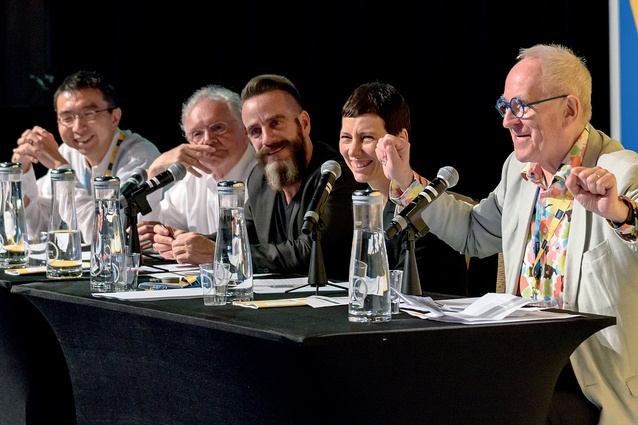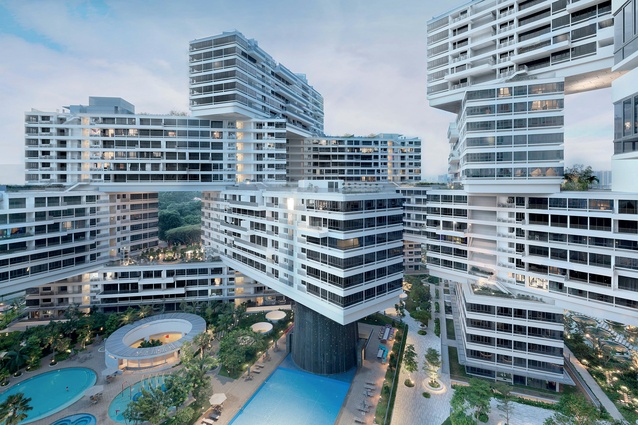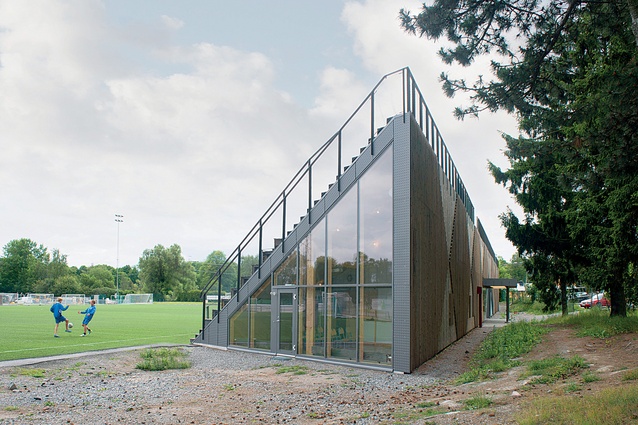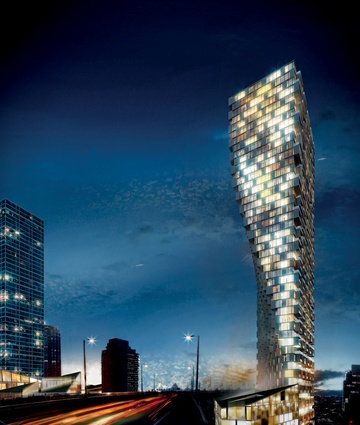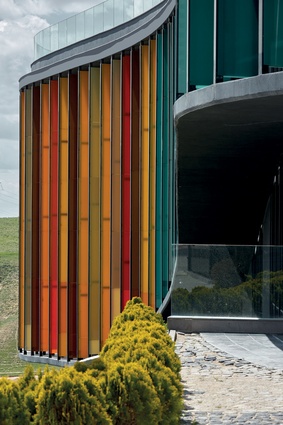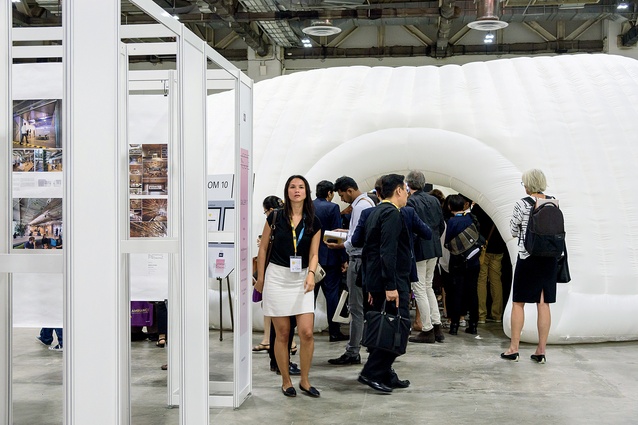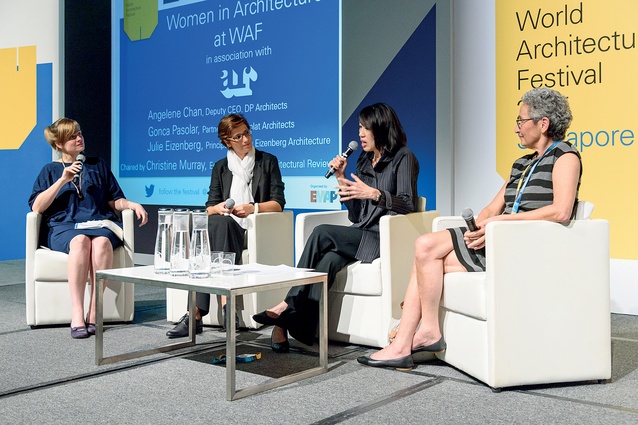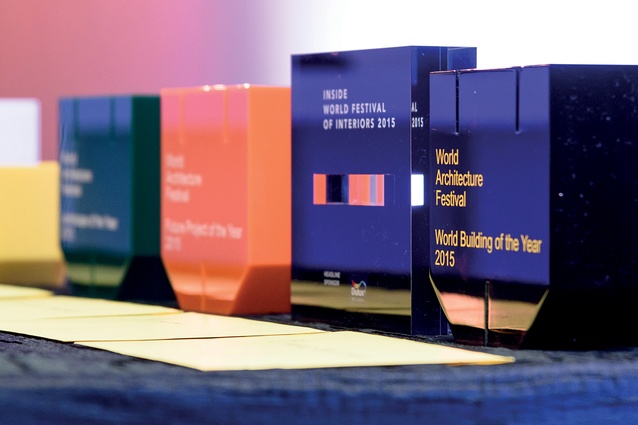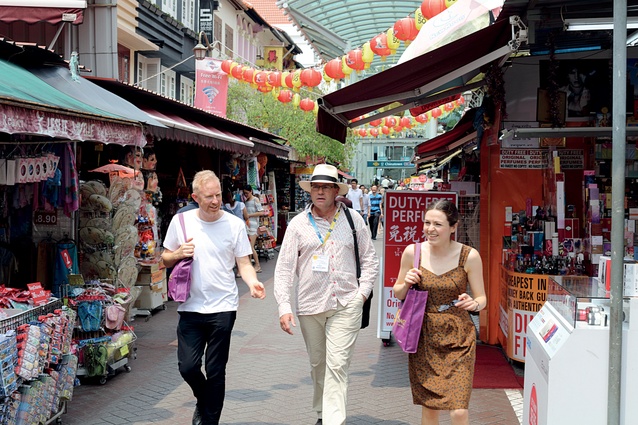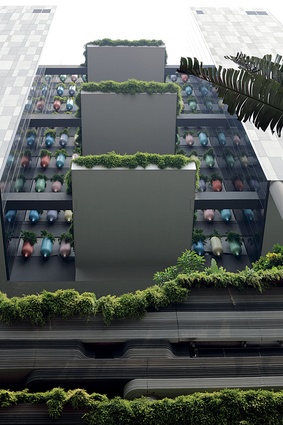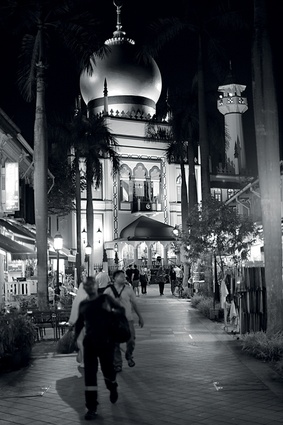Singing for supper
Sixteen New Zealand architects attended the three-day WAF event, held at the Marina Bay Sands Conference Centre in Singapore from 4 to 6 November 2015. A stellar line-up of New Zealand architects presented a total of 12 projects from across Aotearoa but only one firm was honoured. Nelson-based Irving Smith Architects (IS) was highly commended for Mapua Park Structures in the Production Energy and Recycling category.
The coveted Building of the Year award was given to The Interlace in Singapore, by Ole Scheeren of OMA/Buro Scheeren: an intricate configuration of 31 apartment blocks. WAF director Paul Finch described the design as “an example of bold, contemporary architectural thinking” that “presents an alternative way of thinking about developments which might otherwise become generic tower clusters”.
The Interlace tour
Attending WAF to present Te Uru Waitakere Contemporary Gallery in Auckland, Claire Natusch and Julian Mitchell from Mitchell & Stout Architects were among a lucky few to join a tour of The Interlace. Here, they describe the experience:
“This is a truly impressive building but it’s hard to enter – the vigilant guards were onto us at once. No sooner had the word ‘architects’ left our mouths and the gate was shut firmly in our faces. Apparently, no additional explanation was required. Fortunately, our charming host, Phang Chin Ming, from the company responsible for the development, CapitaLand, soon arrived and we were invited inside.
Although a huge development of 1,040 apartments stacked in 31 blocks (each six storeys high) and rising to nearly 90m, it never felt overwhelming in scale. This is helped by the way the hexagonal towers are broken down.

The blocks are stacked in alternating patterns around hexagonal courtyards, with vertical circulation risers where they overlap. By missing every second block, no apartment looks directly into another and sun and airflow penetrate. So, really, the striking aspect of this project is that, despite the rational simplicity of its planning, the building has a dynamic, Jenga-like form with plenty of variation.
Like much of the best architecture in Singapore, the development is helped no end by prolific numbers of trees. They grow thick and fast and are used to good effect here, both on the ground level and on the rooftops. Each of the eight hexagonal courtyards is intimate and different enough to be engaging and scaled for healthy human interaction. Cars are tucked away under the landscaped terrace, so it’s just people and the odd trike or stroller.
A favourite courtyard was the ‘Lotus Garden’ – a large pond full of lotuses with hexagonal stepping stones and large fish. Another was the ‘Pool Garden’ – a sunken landscape with various hot pools and tropical trees for privacy. It looked like a great place to relax if the temperature were ever cool enough. Many high-rise developments purport to create a sense of community – but here they actually seemed to have pulled it off.”
Kiwi success story
Irving Smith Architects’ Jeremy Smith and Andrew Irving are seasoned WAF attendees so it seemed like good karma that they landed a Highly Commended award for their Mapua Park Structures in Nelson. Smith reflects on their win:
“Basically you have to like critique and being critiqued, not just by some fairly high-powered international architects as jurors, but against their buildings as well. This year there seemed to be a larger-than-usual collection of the BIGs and, of course, the OMAs of this world, and an abundance of buildings (and confidences) that were readily familiar from global publishing. But, somewhere in all that, there were plenty of beautiful projects and approaches that were fresh to us and, of course, there was the opportunity for a small (almost budget-less), rewarding community project like Mapua Park Structures to find some ground.”
Challenging typologies
Another WAF regular, Rich Naish from RTA Studio, gave a compelling presentation of Te Kura Kaupapa Māori o Ngāti Kahungunu o Te Wairoa.
“This is our seventh year of being shortlisted at WAF; previously, we have won a category one year and been awarded Highly Commended on two other occasions. Given that New Zealand has a somewhat isolated position in the world, I enjoy, once a year, seeing a cross-section of world architecture. It’s a nice habit to have. This year, we had a record number of Kiwi architects so I spent most of my time watching their presentations and I was impressed.
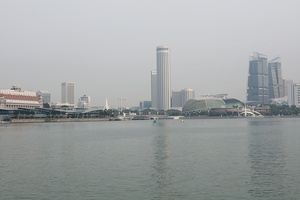
There were plenty of smaller projects: IS’s Mapua Park Structures, Cheshire’s Rore Kahu and Monk Mackenzie’s Canada Street Bridge, for example. They are rich in terms of site and the underlying elements that make a building; which is a uniquely New Zealand thing that we do well. The results didn’t reflect the quality of the projects, which I’m sure were discussed and debated extensively by the judges. However, being awarded Highly Commended was a great result for Irving Smith Architects.
We presented our project later in the day and, since we were presenting in the Schools category, I attended many of those presentations. I was surprised that Te Wairoa was one of the only modern learning environments that challenged the school typology in response to changing pedogogy; the others were mostly traditional cellular classroom typology.
I’m interested in the evolution of a typology and the projects that win seem to be challenging the existing typology. I’m thirsty for what are causing shifts in the architectural world; otherwise, you just see a dressed-up version of the same thing and there’s no point in travelling halfway across the world for the same old thing.”
The futile pitch
Pip Cheshire, director at Cheshire Architects and president of the NZIA, presented Rore Kahu – Marsden Cross Heritage Centre and a lesson in New Zealand history to the jury.
“There was a moment in the World Architecture Festival that the futility of my pitch became appallingly obvious: the death glaze over the eyes of one of the judges as the subtleties of my attempted cross-cultural rapprochement through architecture failed to make an impact. The withering gaze of the judge clearly marked me as some sort of neocolonial trying to sell a memorial to the beginning of white oppression, the beginning of the rot in this gentle land. It’s probably a big ask, that one might explain a project, its location, siting and construction, the parti and the process in 10 minutes, without adding a couple of hundred years of race relations into the mix.

The second time around – same project, different division – the architecture came under fire and I felt that warming around the neck I haven’t really experienced since architecture school. The bow-tied Brit with the unpronounceable name and trail of awful buildings behind him gathered momentum; there was nowhere to go here, no cultural misunderstanding to hide behind, no pub to crawl off to, just his opprobrium and a head full of things I should have said.
Thank God for the Kiwi cheer team. Though we never quite burst into a haka, there was a great sense of camaraderie as we dashed between the inflated doughnuts housing the presentations to hear, see and applaud our mates as they took their turns on the rack.
That is what WAF is: a kind of mix between speed dating and the university crit – practitioners singing for their suppers like undergrads – a delicious mix of pride in having made it that far, coupled with the fall from grace on the public stage. And, for relief, well, a collection of sponsors and a number of lectures, sort of like a conference but without the zeal of a national institute on show; this is, after all, a business – a walking, talking vanity press.”
Why build in such a beautiful natural environment?
Andrew Mitchell attended WAF with fellow director Davor Popadich from Patterson Associates.
“We made the decision earlier in the year to enter more than one project. At the WAF event, there were three projects to present: Christchurch Botanic Gardens Visitor Centre, Scrubby Bay House and Olive Grove at Annandale Farm, Banks Peninsula.
While the 10-minute presentation followed by a 10-minute critique was the same format as in previous years, the event was held now in the vast ground-floor event space. White, round, inflatable crit rooms felt less formal than did the venues of previous years but suffered a little from external noise creeping in. We felt these crit spaces were more akin to the event and to the wonderful projects being debated within, than to the stock conference spaces of last time.
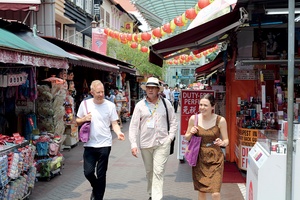
Generally, it seemed as if the first-round judges were probing for highly compelling social and poetic content. This didn’t seem to translate to the Super Jury, which was far more brutal and simply wanted ‘Great Architecture’. Even a nuclear-radiation-proof community playroom in Japan wasn’t immune to Sir Peter Cook’s highly entertaining wit.
The New Zealand landscape posed the usual conundrum for the international judges: why do we all build in such a beautiful natural environment? This provided much debate with the other Kiwi crew over a red wine or two. Conclusion: let’s wait for Jeremy Smith’s PhD for the answer! The collegial nature of the event was great and we’ll be back again for sure.”
Business trip
Alongside his co-director, Dean Mackenzie, at Monk Mackenzie, Hamish Monk presented Canada Street Bridge, Auckland, within the Future Project category.
“We had an eventful trip with a few too many late nights and airport lounges (eight flights in nine days). We coupled our trip to WAF with business trips to Kuala Lumpur and Hong Kong. Over the past few years, we have been making small inroads into work in Asian cities, so touched base with a few clients to check on current and potential work streams – basically lots of drinking and eating – and we came back a few kilos heavier and with gout. Unfortunately, we didn’t take out the big prize in our category but we had a good response to our presentation. Next time!”
The perfect pitch
Blair Farquhar, with Paul van Lent from Wingate+Farquhar, presented Tauranga’s Kathleen Kilgour Centre to the jury.
“Overall, the experience was really worthwhile. It was encouraging to compare our work on an international stage and to come away thinking that we were not that far off the mark. We were presenting on the Thursday morning and, therefore, we had the advantage of sitting in on presentations on the Wednesday.
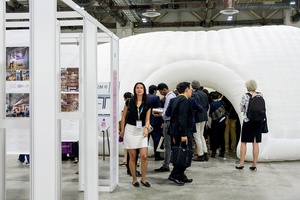
Some of them did not go that well – particularly with respect to time management. Consequently, we scurried away in the afternoon and put a bit of effort into refining our own! This was time well spent. We were pleased with our presentation and its reception. We felt we had a good hearing. The jurors ‘got’ the building and their comments were highly relevant and insightful, and helped us reflect on our own design decisions.
Ten minutes is not long and we had to be ruthless in the design aspects on which we concentrated – cutting out some aspects reluctantly. Question time, however, gave us the opportunity to expand on the very aspects we had dropped – a testament to the jury’s degree of understanding of the project.
The presentation inflatables worked well. They created an appropriate environment – not totally isolated from the larger event – and allowed for an audience size which was not intimidating. We concentrated on sitting in on project presentations rather than hearing many of the speakers – you had to make a choice – and, I think, this is the real advantage that WAF offers. After all, you can go to conferences or surf the net to glean the opinions of prominent figures in the world of architecture.
If I had a criticism, it would be that the event feels overly Anglo-centric: not in terms of the projects selected but in the event’s tone and values. Hardly surprising; however, I think Paul Finch needs to cast his net a bit more widely than his old chums of a certain age (Sir Peter Cook, Jeremy Melvin, Charles Jencks, Will Alsop, Alan Balfour) and indeed pay more heed to the term ‘World’ in the title. I sat through nearly all of the Super Jury presentations and didn’t feel that the presenters were afforded the same degree of understanding from which we benefited in ours.
We enjoyed the gala dinner. We had a suitably international table with representation from Canada, Germany, Italy, and Singapore. That was the occasion where we most engaged with the ‘World’.”
First timer
First timer at WAF, Warren and Mahoney’s Blair Johnston, offers some thoughts about the experience:
“In an inversion of anticipation, the event itself is completely humbling: architects presenting within inflatable ‘rooms’ in a windowless conference hall amidst the usual trade fair ensemble of sponsors shilling shower heads and fibre cement sheeting.
Equally, and as something of a WAF cynic, I was surprised by the uniformly high standard of the short-listed work. While the projects represented are conceptually diverse and covered a broad range of typologies, budgets and scales – the clarity of thought and the quality of communication was clear. In such a context, it is an honour just to have our work represented.
While the presentation setting itself is not intimidating in the slightest, the tension is elevated by the presence of one’s peers. A compelling story, confidently told remains the key to an engaging presentation – and no amount of art-directed video content can conceal shaky conceptual foundations or a shaky presenter.
I enjoyed the collegiality and support of the New Zealand contingent. I was proud to present our work in an international context and, ultimately, highly disappointed not to win the category. While I enjoyed the experience, the value for me was linked intrinsically to presenting the work – I don’t think I would necessarily attend purely as a spectator.”
The standout firms
Andrew Barclay, also from Warren and Mahoney, critiques the projects and presentations:
“The overall standard of work was higher than it has been in previous years and the variety of typologies and scales was wider. There was a noticeable drop in European work but the work I saw presented live was of a very high quality.
The best of the best was presented superbly – notably, work by Ingenhoven Architects, Nikken Sekkei and Grimshaw – which reminded us that we have some way to travel yet as a practice to be right at the top level, both in terms of work and presentation. The best work was unremittingly single-minded, with a simple overall concept and a limited application of materials.
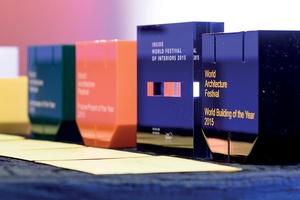
For me, the most memorable work (again presented by the three practices mentioned above) was systematic and resisted any attempts to lay down all of one’s ammunition on one target. The architects of the best work were restrained and content to let a good idea be enough to carry the design.
The New Zealand work (at least in my opinion) was pretty uneventful but competent. I saw nothing this year that was really world class, although I really liked Patterson Associates’ little job on Banks Peninsula, Canterbury. Australia continues to pump out lots of very well-resolved work. This year, the standout firm for me was Cox Rayner Architects, whose work shows a very high level of craft, even when the projects are pretty large and programmatically complex.
In terms of what made it worthwhile – I think seeing international architects present live is both humbling and reassuring. The New Zealand contingent all presented well – as well as most of the other contenders – but the very best are a lot better than any of the New Zealand firms in the communication arena. Again, Ingenhoven and Grimshaw take the prize there.”
On the jury
Architecture New Zealand’s editor Justine Harvey reflects on her experience as a jury member in the House category:
“I had a similar experience, sitting on a WAF jury, to that of last year. While judging at WAF is fun, it certainly isn’t without its challenges. The presenters smile at you sweetly and try to read every facial and bodily movement for any clue to your prejudices and appreciations. Within 20 minutes, you have to assess each project against a dozen or so other top-notch projects which you’ve never actually seen in real life. Sometimes you have to intensely stare down presenters, who are using English as a second language, in a concerted effort to give sense to the words.
Then, after the awards announcement, you often have to justify the jury’s decision-making directly to the faces of these talented architects who, aside from the years of designing and building their architectural masterpieces, have flown for hours and put up serious money for hotels and flights to present their wares at WAF.
But it is what it is. Without doubt, the event is inspiring and exciting. It is like being back at university, where clever and random ideas are flying around and everyone is jockeying for position.

I found some of the lectures particularly interesting. Terreform founder Michael Sorkin proposed a completely self-sufficient New York City. He suggested that “the city is actually disappearing” due to “uniformity of place” and the “ubiquitous oozing of global zoning and centralising planning”. He encouraged citizen empowerment with tactical, do-it-yourself urbanism to counter “the grotesque gap between rich and poor - the one per cent holding all of the cards”.
Professor Dirk Hebel from ETH Future Cities Laboratory gave fascinating insights into new developments in producing glass, concrete and engineered bamboo to counteract environmental impacts.
A few of us in the Kiwi contingent took an informal tour of some of WOHA’s buildings, including the new School of the Arts and the ParkRoyal on Pickering, which was well worth the effort, even in the hot midday sun and humidity.
While the awards weren’t plentiful for New Zealand, I felt really proud of our Kiwi architects. The world is becoming smaller and, despite being at the bottom end of globe, events like WAF (and the Venice Biennale) provide opportunities for Kiwi architects to step outside their comfort zones and to show the world where we are at.”
Next year, WAF will be held in Berlin.

